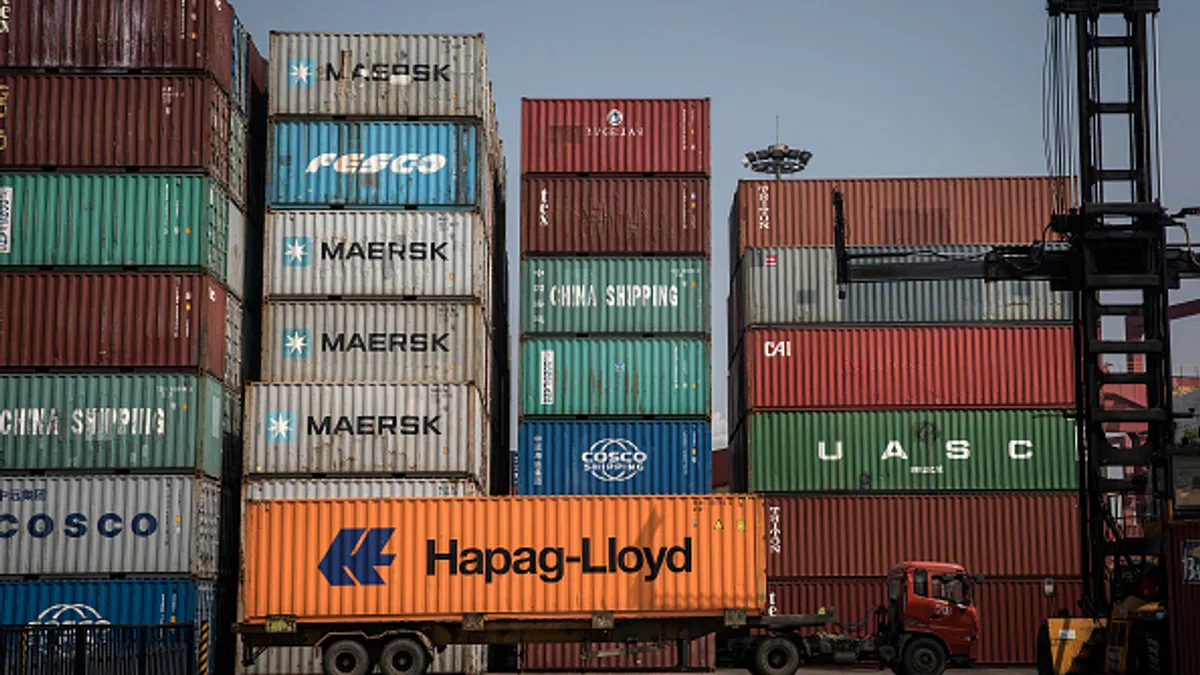The dark days for retail aren't over.
Forever 21's Chapter 11 filing is the latest reminder that the economic climate for many sectors of retail is still brutal. So far this year there have been more than 7,000 store closures — more than any full-year total to date — and 16 major bankruptcies.
Since the summer of 2017, when retail bankruptcies were reaching Great Recession-era levels, Retail Dive has compiled regular lists of distressed retailers potentially at risk of bankruptcy.
For about the past year and a half, Retail Dive reporters and editors have generated the list with data from CreditRiskMonitor, which has a proprietary metric (FRISK) that measures the risk of a company filing for bankruptcy within 12 months. It's based on several factors, including credit ratings, stock volatility, financial metrics and proprietary data around the use of CreditRiskMonitor's platform.
From FRISK data, we cull the retailers relevant to our coverage of the industry (i.e., non-food consumer-facing retailers with a significant U.S. presence) that have the highest risk scores. Since April 2018, this method has led to lists with eight to 12 retailers.
This year, compiling the list the same way, CreditRiskMonitor data yielded 28 retailers with significant bankruptcy risk.
That is more than double the number on any of our previous lists. It is an eye-popping figure, so much so that Retail Dive reached out to CreditRiskMonitor executives to make sure there were no changes in the FRISK methodology. There were not.
That leaves the possibility that there is just more risk in the retail world than there was when we compiled these lists in the past.
Retailers with a high chance of bankruptcy
Chart includes retailers with FRISK scores of 1, a 9.99% to 50% chance of filing for bankruptcy
| Name | Sector |
|---|---|
| Ascena | apparel |
| Christopher & Banks | apparel |
| Destination Maternity | apparel |
| J. Crew | apparel |
| Neiman Marcus | department stores |
| J.C. Penney | department stores |
| Chewy Inc. | pet |
| Rite Aid | drugstores |
| Pier 1 | home |
| Steinhoff (Mattress Firm) | home |
| Bluestem Brands | apparel and home |
| Camping World | outdoor |
| Trans World (parent of FYE) | specialty |
Source: CreditRiskMonitor's FRISK scores as of Oct. 1
There are even more retailers with an elevated risk of bankruptcy based on CreditRiskMonitor's analysis and ratings.
Retailers with an elevated risk of bankruptcy
Chart includes retailers with a Frisk score of 2, a 4% to 9.99% chance of filing for bankruptcy
| Name | Sector |
|---|---|
| RTW Retailwinds (New York & Co) | apparel |
| Tailored Brands | apparel |
| Express Inc. | apparel |
| Francesca's | apparel |
| J. Jill | apparel |
| Hudson's Bay | department stores |
| Stein Mart | department stores |
| Container Store | home goods |
| Kirkland's | home goods |
| Sears Hometown and Outlet | home improvement |
| Overstock | home goods |
| Signet Jewelers | specialty |
| GNC | specialty |
| At Home | home goods |
| Build-A-Bear | toys |
Source: CreditRiskMonitor's FRISK scores as of Oct. 1
And that number doesn't even include the full range of retailers that could go bust, as FRISK scores only cover companies with publicly traded stock or debt. Looking at Moody's distressed ratings, there are an additional five retailers that aren't listed in CreditRiskMonitor's scores. Moody's distressed ratings signify a high level of default, which could include restructuring moves like distressed debt exchanges in addition to in-court debt restructuring. The outlook indicates analyst expectations for future rating changes.
Retailers rated as distressed by Moody's
| Name | Rating | Outlook | Sector |
|---|---|---|---|
| 99 Cents Only | Caa1 | stable | discount |
| Academy Sports + Outdoors | Caa1 | negative | sporting goods |
| Guitar Center | Caa1 | stable | specialty |
| J.C. Penney | Caa1 | stable | department stores |
| Bluestem Brands | Caa2 | negative | apparel and home |
| J. Crew | Caa2 | developing | apparel |
| Indra Holdings (Totes Isotoner) | Caa3 | negative | apparel |
| Neiman Marcus | Caa3 | stable | department stores |
| Pier 1 | Caa3 | stable | home |
| Toms Shoes | Caa3 | stable | apparel |
Source: Moody's
And there are yet another six retailers not included in any of those lists that are among Fitch's "Loans of Concern." Fitch's list is based on borrowers' low credit ratings, market prices of their loans and adverse information or events around the company.
Retailers on Fitch's "Loans of Concern"
| Retailer | Sector |
|---|---|
| Serta | home |
| J.C. Penney | department stores |
| J. Crew | apparel |
| Ascena Retail Group | apparel |
| Toms Shoes | apparel |
| Indra Holdings | apparel |
| Pier 1 | home |
| Iconix Brand Group | apparel |
| NYDJ Apparel | apparel |
| Neiman Marcus* | department stores |
| Petco* | pet |
| Academy Sports + Outdoors* | sporting goods |
| Joann Stores* | specialty |
| Bluestem Brands* | apparel, home |
| Blue Nile* | specialty |
Source: Fitch Ratings. * indicates retailer only on Tier 2 list
Even that list — 39 retailers, at elevated risk of bankruptcy and default — isn't complete given the number of retailers without rated debt or risk ratings available to Retail Dive. Plenty of retailers have filed for bankruptcy but never made our watch lists because they didn't have FRISK scores or credit ratings. Included in that list just from this year are: A'gaci, Avenue Stores and Barneys New York.
All of this is to say that we are seeing highly elevated risk levels in major segments of the industry, especially for apparel retailers. The factors behind the risk are largely the same as they've been in recent years. Hefty debt loads (often from private equity buyouts) have run into heightened price competition, declining mall traffic, and accelerated e-commerce adoption and other technological changes.
Meanwhile, the strong players keep getting stronger and better, making life more difficult for the weak and indebted. Tariffs and macroeconomic concerns can't be helping, either.
"Most" retailers are over-stored and 30% of current retail space could be nixed in its current form, according to investment bank B. Riley Financial and Scott Carpenter, the head of B. Riley's liquidation arm, Great American. B and C-class malls are likely to be the main theater of those closures. Carpenter predicts that our current era of consolidation could last another 18 to 24 months, according to a B. Riley note from September.
Here is a deeper look at a few of the retailers with the highest bankruptcy risk:
J.C. Penney
Since J.C. Penney's second quarter earnings release in August, S&P Global and Fitch have both downgraded the department store retailer deeper into junk territory. Many analysts think the company has enough liquidity to stay afloat in the near term but see its debt load as unsustainable in the long run.
Making it harder to de-leverage are the company's constantly sliding sales. Q2, with net sales down more than 9%, was a reminder of just how difficult a turnaround is going to be for CEO Jill Soltau and the team she's installed this year. The retailer has lost ground to off-pricers, is hurting from slowdowns at malls and is trying to break a long-running cycle of over-buying and discounting. Its $300 million-a-year interest expense means it has little money to throw at a turnaround and perhaps just as little room for error.
Stakeholders were so jittery earlier this year that, following a news report that Penney was working with advisors, the retailer felt compelled to state specifically that it was not working on a bankruptcy filing.
Pier 1
Home goods and decor retailer Pier 1 expected a bad second quarter, and it got one. Top-line sales fell 14.3%, comparable sales were down 12.6% and net loss nearly doubled to more than $100 million. Executives said this was expected, as the retailer clears inventory as part of a merchandising reset in time for the holidays. But with its sales base shrinking, Pier 1 is looking to close 70 stores, or more — up to 15% of its footprint, if it can't make performance targets.
Past efforts at a reset have not panned out for Pier 1, with already fierce competition in the category heating up. Wayfair, Home Goods, Amazon, Target, Walmart — the list of strong competitors is long. After an abysmal Q1 for Pier 1, Debtwire retail analyst Philip Emma wrote in a note that "the results were so bad that a good case can be made for going straight to a liquidation as the best case scenario for preserving value for as many stakeholders as possible."
Destination Maternity
Q2 was so rough for maternity apparel retailer Destination Maternity that the company is considering a possible sale, along with asset sales and stand-alone turnaround options. Top-line sales were down 12% and comps fell 10.5%. The retailer managed to reduce expenses, in part through layoffs, but also saw its margins shrink.
It gets worse. In its Q2 filings, the company issued a "going concern" warning, indicating "substantial doubt" about Destination Maternity's ability to survive as an operating business. That is partly due to one of its lenders increasing availability reserves, which could hurt Destination Maternity's liquidity. The company has also hired financial advisors and has started talks with lenders and third parties about alternatives. That process could include a bankruptcy, the company said.
Ascena
In August, Ascena threw cold water on reports that it was having communication issues with its lenders that led them to think the apparel retailer was considering a bankruptcy. Like Penney, it may have felt compelled to do so because of how much concern there is around the retailer, which owns Loft, Ann Taylor and Justice, among others.
This year, the company has turned over multiple c-suite executives, sold off a majority stake in Maurices, moved to shutter Dressbarn and is reportedly mulling the sale of Lane Bryant and Catherines — all in an effort to stanch financial bleeding and its drift into penny stock territory.
Neiman Marcus
Until the most recent reporting period, Neiman Marcus managed to string together six straight quarters of positive comps. That ended in June, when the luxury department store chain reported a comps decline of 1.5%. Even in periods of sales growth, the retailer still posted losses as its interest expenses ate into operating profits.
As it tries to manage $4.5 billion in long-term debt, Neiman has cut a deal with lenders and is looking to sell its well-performing MyTheresa unit. The e-commerce business has been the subject of multiple lawsuits after it was moved around in Neiman's corporate structure. In the most recent suit, UMB Bank alleged the unit was moved out of the reach of lenders (in a possible default scenario) at the behest of Neiman's private equity owners to "tighten its stranglehold over the Company's creditors." Neiman has called the allegations "meritless."
Correction: A previous version of this story misstated the category of retail Joann operates in. It is a specialty arts and crafts retailer.






















